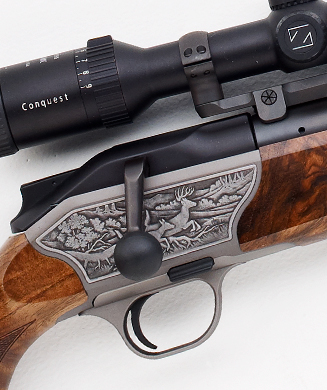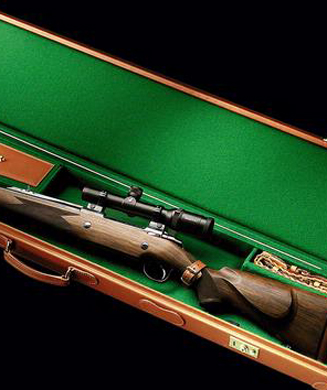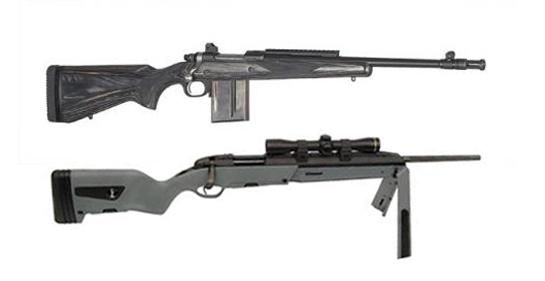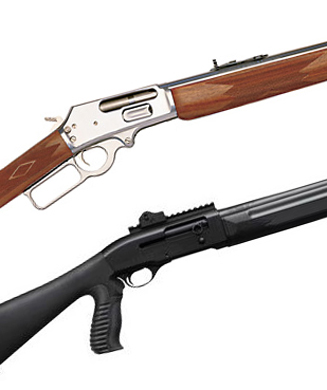We may earn revenue from the products available on this page and participate in affiliate programs. Learn More ›
Competition shooting runs in cycles, and right now it’s 3-gun’s time to shine. If you love to shoot but have not tried 3-gun yet, you are behind the curve. Three-gun is action-packed shooting that leaves everybody giddy with excitement. The best part is, you probably already have the guns you need to get started.
Here are a few suggestions on how you can pimp them out to make them a bit more competitive. The most popular division is Tactical Optics, so we’ll look at the semi-auto guns for that class.
Most of this is bolt-on equipment and easy for a do-it-yourself installation.
Rifle
If you have an AR-15 in the M-4 carbine style, you have a decent foundation for getting started. The AR-15 is the ultimate “kit” gun, and there are a lot of aftermarket parts that will get you in the game.
Muzzle Brake
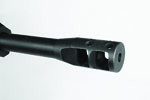
Most shooters wonder why you would need a recoil brake on a rifle shooting the .223 Remington cartridge. It’s because 3-gun is a game of speed. The shooter who hits all the targets the fastest wins. You will engage multiple targets, and many of them will require two hits or more each. So, if you can control the recoil, you can control the sights and you can get back on target faster.
There are a lot of very good brakes on the market. A few years back I did a test of several and can say that they all worked well. I doubt you could go wrong with any brand-name brake. My competition rifles all have JP Compensator brakes, and I am very pleased with the performance.
Installing a muzzle brake is easy. Unscrew the flash hider and install the brake tightening against a crush washer until it’s lined up correctly. Most shooters like to cock the brake angle slightly to allow for a right- or left-handed shooter.
Scope Selection
The Tactical Optics division allows one optical sight, and it is universally installed on the rifle. The traditional choice for most shooters is a 1–4X scope. A true 1-power scope allows the shooter to keep both eyes open when engaging close-range targets. The 4X is enough magnification for most of the longer targets. Of course, this depends on the region.
In the Northeast, where I live, targets beyond 300 yards are rare, but in the Western states, that’s just getting started. West of the Mississippi a shooter may be faced with hitting targets at 500 yards or more. So, some shooters will pick a higher magnification scope and find a way to cope with the “in-your-face” close-range targets.
My rifle has the new Swarovski Z-6i, 1-6×24 with the BRT reticle. The illuminated dot is visible in daylight and with the scope on 1X, I can easily shoot with both eyes open, even though I am cross-dominant. During the 2011 Rocky Mountain 3-gun competition, I used this scope on targets out to 600 yards and never once felt handicapped by the 6X magnification. I also shot some targets so close I left powder burns on the cardboard.
You will be called on to move the scope power ring very fast as you transition from target to target. The MGM Switchview lever clamps on the power ring of the scope and allows you to change magnification very fast.
Scope Mount
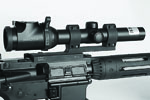
Mounting a scope on an AR-15 rifle can be a challenge. It requires that the scope be positioned high, and getting it far enough forward is often a problem. You will need a mount designed specifically for an AR-15 rifle that extends the front ring forward of the receiver. Mounts from Larue Tactical, JP Enterprises, Warne and Safariland are a few that I have tried and can recommend.
Any rifle is only as good as its trigger. If you have a “mil-spec” rifle, do yourself a big favor and install a new trigger. There are a lot of good drops in triggers like the AR-15 Gold or Timney. Or if you prefer a conventional-style trigger, the JP is the gold standard. Their new model is easy for anybody with 10 working fingers to install.
Bolt Release

You should have a tactical bolt release to allow easy access to lock back the bolt and to release it after a bolt-lock mag change. Or check out the Magpul B.A.D. (Battery Assist Device) lever. This cool little tool lets you do it all with your trigger finger.
A tactical, oversize lever on the charging handle is another “must.” That’s so you can hit it fast to work the bolt
on your gun with one fast motion.
The options for bolt-on swag are infinite for an AR-15 rifle, but these will get you in the game.

Shotgun
Unlike a double-barrel quail gun, your 3-gun shotgun must serve multiple masters. Targets might be stationary or moving, close or far, big or small, single or multiple—often all in a single stage. The gun will need to handle birdshot, and sometimes buckshot, and must be able to hit small targets at long range with slugs.
Magazine Extension
The first bolt-on shotgun addition will be a magazine extension. The Tactical Optics division allows a 9-shot capacity, which means an 8-shot magazine.
There are plenty of good magazine extensions on the market, and a stroll through Google will show a staggering number of options. But don’t shop on price alone. You only need to see one tube fail, spewing ammo, springs and parts during a match, to know the value in the term “trouble-free.” My Benelli M2 shotgun has a rugged Nordic Components metal magazine extension, and I can honestly say it takes a licking and keeps on ticking.
Sight Conundrum
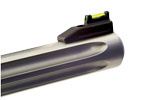
Sights are a trickier thing to deal with. Some top shooters use only the bead on the shotgun, while others use elaborate adjustable sighting systems.
I don’t like anything too big in front of my eye to distract me from shooting at moving targets, yet I need more than a bead to hit the slug targets. My choice is a set of low-profile fiber-optic sights. They are available from TruGlow, HiViz and a few other companies.
Other Options
The shotgun will need an extended charging handle and oversize bolt-release button. The bolt release will require gunsmithing to install, as it requires drilling and tapping a screw hole.
Some shooters like to install an oversize safety button, and a lot of shooters will bevel the magazine loading port to help “funnel in” the shells while loading.
Handgun
Most competitors use a high-capacity 9mm handgun. Mine is a SIG Sauer P226 X-five competition, but if you have a Glock, M&P, SD or any other high-capacity gun, you can work with it.
Trigger Tweaks

The biggest favor you can do yourself is to make sure you have a very good trigger. It’s best not to mess with the trigger yourself, but instead take it to a good gunsmith. Ask for a 3-pound pull weight, but be prepared to accept 4 pounds. If he can shorten the reset, that will help as well.
Sights

It’s also important to have sights that you can pick up very quickly. I like fiber-optic sights with contrasting colors. You might be happier with a white dot or even night sights. The important thing is that you can pick them up very fast and that they are adjusted so your bullets strike at the point of aim. Dawson Precision is an excellent source for handgun sights.
Grip Tweak
It’s important that the grip fits you well and that you can reach the trigger correctly. If you have big hands, you might put in an extension, while short-fingered shooters will want to be a bit closer to the trigger. Some guns come with several blackstrap options so you can try them to find one that fits your grip well. Most popular guns also have a wide range of aftermarket grips and grip accessories.
You might also consider adding a beveled magazine well, or modifying your existing mag well to aid in fast reloads.
Polish
Some shooters like to polish the internal parts, but if a pistol runs well, does not jam and is accurate, I like a hands-off approach. I think that the single most important thing a handgun (or any competition gun, for that matter) must do is go bang every time you pull the trigger. The more you mess with a functioning handgun’s operating parts, the more you increase the odds of introducing problems with little potential gain. If it works, don’t fix it. I believe in an ammo-gunsmithing approach to this chore. If you burn enough ammo, the parts polish themselves.
Range Time
The very best thing you can do with your guns is shoot them. Get them tweaked out so they work and fit you well, and then spend your money on ammo. The cold, hard truth is that practice is what litters the path to the winner’s circle.
For more, check out Range365: Shooting Off at the Mouth: Chad Adams



